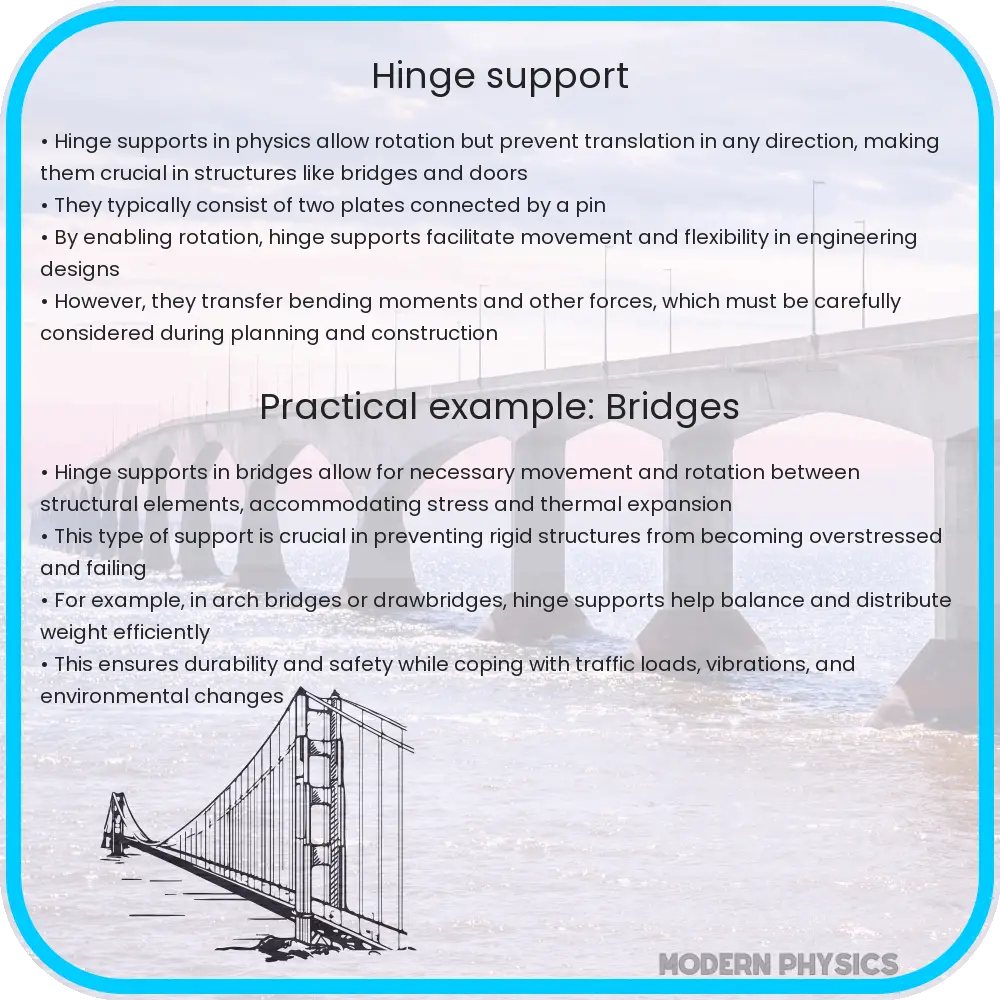Explore hinge support in engineering: key insights into load-bearing capacity, stability, design factors, and sustainability in hinge applications.

Hinge Support in Engineering: Understanding Load Bearing and Stability
Hinges play a crucial role in various engineering applications, providing pivotal support and facilitating movement in doors, gates, and other moving assemblies. Their importance in load-bearing and stability cannot be overstated, as they often serve as the critical point of support in many structures. This article delves into the essential aspects of hinge support, focusing on load-bearing capacity, stability considerations, and design factors.
Load Bearing Capacity of Hinges
The load-bearing capacity of a hinge refers to the amount of weight or force it can support without failing or deforming. This capacity is determined by various factors, including the material composition, size, and design of the hinge. Common materials used in hinge construction are stainless steel, brass, and aluminum, each offering different strengths and weaknesses. For instance, stainless steel hinges are known for their high strength and corrosion resistance, making them ideal for heavy-duty applications and outdoor environments.
Stability Considerations
Stability in hinge design is about ensuring that the hinge can maintain its integrity and functionality under various conditions. This includes factors like resistance to wear and tear, environmental resilience, and the ability to withstand dynamic loads. For instance, in applications where hinges are exposed to high-frequency movements or varying load directions, choosing a design that can accommodate such stresses is crucial.
Hinge Design Factors
The design of a hinge significantly influences its performance. Key design factors include the type of hinge (e.g., butt, pivot, or continuous), the number of knuckles, and the presence of any reinforcing features. Additionally, the method of attachment, such as welding or bolting, impacts the overall strength and load-bearing capacity of the hinge assembly.
One must also consider the movement range and the angle of rotation required for the specific application. For example, a door might require a hinge that allows for a 180-degree rotation, while a laptop hinge may need to accommodate a 360-degree rotation.
- Type of Hinge: The choice between a butt hinge, pivot hinge, or a continuous hinge depends on the application’s specific needs.
- Number of Knuckles: More knuckles can distribute the load more evenly, enhancing the hinge’s strength.
- Reinforcing Features: Features like thicker leaves or additional pins can increase the load-bearing capacity.
Understanding these aspects of hinge support is essential for engineers and designers who aim to create structures that are both functional and durable. The correct selection and design of hinges ensure that the moving parts of a structure operate smoothly and reliably under various conditions.
Advanced Considerations in Hinge Design
When designing hinges for specific applications, advanced considerations play a pivotal role. These include the analysis of stress distribution, the use of finite element analysis (FEA) for predicting performance under load, and the selection of appropriate lubrication or surface treatments to reduce wear and increase longevity.
Stress distribution within the hinge is crucial, especially in high-load applications. Uneven stress distribution can lead to premature failure. FEA tools allow designers to simulate various load conditions and optimize the hinge design accordingly, ensuring even stress distribution and identifying potential weak points.
Lubrication and surface treatments are also essential. Proper lubrication reduces friction and wear, thereby extending the lifespan of the hinge. Surface treatments like galvanization or anodizing can enhance corrosion resistance, especially important in outdoor or harsh environments.
Environmental Impact and Sustainability
In today’s eco-conscious world, the environmental impact of materials and manufacturing processes is a vital consideration. Selecting materials that are sustainable and environmentally friendly, like recycled or recyclable metals, contributes positively to sustainability efforts. Additionally, manufacturing processes that minimize waste and energy consumption are increasingly favored.
For example, using recycled stainless steel for hinge production not only reduces the environmental footprint but also ensures the durability and longevity of the hinge, as stainless steel is known for its strength and corrosion resistance.
Customization and Innovation
The field of hinge design is not static; it continually evolves with technological advancements. Customization has become a significant trend, with hinges being tailored to meet the unique requirements of specific applications. Innovations in hinge design, such as smart hinges equipped with sensors for monitoring wear or stress, are on the rise, paving the way for more intelligent and responsive engineering solutions.
Conclusion
In conclusion, hinge support is a multifaceted aspect of engineering that involves understanding load-bearing capacities, stability, and design intricacies. The choice of material, design parameters, and consideration of environmental impacts play crucial roles in the overall performance and sustainability of hinge systems. As technology advances, so do the possibilities for more innovative, efficient, and environmentally friendly hinge designs. Engineers and designers must stay abreast of these developments to create effective and sustainable solutions for the myriad of applications that rely on hinges. Ultimately, the meticulous design and selection of hinges are pivotal in ensuring the functionality and longevity of moving assemblies in various engineering applications.
